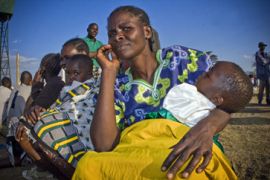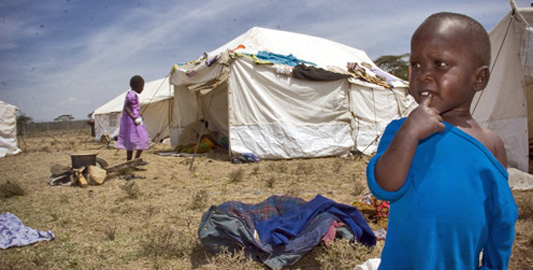Naivasha’s ‘Camp Darfur’
Displaced Kenyans in country’s flower-growing region long for home.

 |
| Families fleeing post-elections violence in the Rift Valley Province have moved into Naivasha’s Camp Kedong’ [Stephen Digges] |
Hundreds of white tents dot the landscape in the lakeside town of Naivasha in the Rift Valley province, the heart of Kenya’s largest flower-growing region.
They are part of the newly-constructed Kedong’ Camp which lies 60km west of Nairobi, the capital.
In late January, government and aid agencies began building Kedong’ to house internally displaced persons fleeing the post-elections violence which erupted after Raila Odinga, a Luo opposition candidate, accused Mwai Kibaki, the Kenyan president and a Kikuyu, of rigging the vote.
Initially, Naivasha had been spared the violence and strife, but within a few weeks, the clashes between pro-government and opposition supporters spread here as well, leaving some 100 people dead and more than 10,000 displaced.
The Kikuyus started targeting the Luos in Naivasha in revenge for members of their community who had been flushed out and killed elsewhere in the Rift Valley.
Issako Jirma, the Red Cross camp manager, says the camp is projected to function fully and accommodate displaced persons for the next year.
“But even if it takes longer than that, we have constructed the camp in such a way that it can run well for the next five years,” he added.
Jirma points to semi-permanent structures which have been built and the scaffolding of others still under construction. He says Kedong’ is a better organised camp than other such facilities which have been set up in Naivasha over the past few weeks.
IDPs arrive
Construction workers are nearly finished building food storage shelters, watch towers on every corner, floodlights, latrines and proper fencing.
| In Video | ||
|
George Anyona, the district commissioner for Naivasha, told Al Jazeera that the government will also provide security at the camp and ensure that the workers from the nearby flower plantations have armed escort to and from their workplace.
He said: “There will be armed army officers patrolling the camp at night, and an administration police post will be based here at the camp during the day.”
When Al Jazeera visited Kedong’ last Sunday, some 1500 IDPs had just arrived on five buses owned by the Homegrown Flower Company, one of the major flower growers in Naivasha.
They had been ferried from police stations, prison grounds and greenhouses where they had sought refuge from the violence of the last few weeks.
Immediately after disembarking, the IDPs registered with the Red Cross and then queued up to receive a five-day family kit ration of food, including corn, vegetable oil, parsley, and soya flour.
The kit also contains five cooking pots, a knife, two blankets, a mosquito net, three packets of sanitary towels, five plates, five spoons and five bowls.
As the families moved into the tents and shelters, children ran around the camp, oblivious to the turn that their lives have taken.
Adults huddled in groups to fight off the early morning chill; some made fires outside their tents to prepare breakfast.
Pastor George Odhiambo, who is among the displaced, began conducting a service under a tree – dressed in his full ceremonial regalia.
But only two people attended his sermon.
Nevertheless, he urged everyone to “take courage in the face of great adversity” and to find strength in their religion in spite of the obvious conflict.
Camp Darfur
 |
| The Kenyan Red Cross distributed food and supplies to each family [Stephen Digges] |
But Meshack Omondi, a day labourer with Homegrown Flower Company, has grown bitter that innocent families have been driven from their homes by the violence.
“I would call this camp Darfur,” he told Al Jazeera in reference to south-western Sudan’s refugee crisis.
He said: “It is not appropriate to live in these conditions with our wives and children. Those of us who opted to remain behind and work [in the flower plantations] have sent our families back to our rural homes in the Luo Nyanza Province.”
Omondi says he feels betrayed by the politicos in Nairobi.
“Kibaki and Odinga only know me when it comes to [wanting] – my vote. Their peace talks of power sharing in Nairobi can contribute very little to my life.”
“The only thing that will benefit me right now is peace, and a good economy.”
Flower season
Like Omondi, many of the displaced people here work in the various massive flower farms in Naivasha which have traditionally attracted a multi-ethnic work force population.
The Rift Valley province has been Kenya’s flower basket, accounting for about 60 per cent of the country’s cut flowers, and an economic boon.
Most of the flower farms in Naivasha are owned by Europeans or Kenyans of European descent. Though they have not been a target in the ongoing clashes, they have been greatly affected in lost manpower as targeted workers have fled their homes and fear travelling to work.
Ongutu, a 36-year-old clerk at the Homegrown Flower farm, told Al Jazeera: “There is a huge demand for Kenya’s cut flowers from Europe and the US and with Mother’s Day coming up, there would be no time for [the flower growers] to train new staff.”
“Our employers had to beg us not to leave. That is why they hurriedly constructed this camp so that some of us would be convinced to remain.”
Life-long homes
Ongutu has lived in Naivasha for 18 years and say he does not want to go back his ancestral home in Luo Nyanza Province.
“This is where I have been all my working life. I came to Naivasha alone, got married and now have three children. It has been a challenge for me to explain to my children what has been going on,” he said.
“I have had to tell them that they might have to go back home, and they cannot understand this because this is the home they have known all their lives.”
For many of the refugees here, the security of the camp has provided a reprieve. But when they narrate their ordeals, tears swell in their eyes and they shiver with anger and fear as they recall the gruesome killings of friends and relatives.
Most of them still have relatives missing or loved ones still housed in the Naivasha District mortuary.
“There is no money to take the body home for a proper burial,” says one old man about his dead wife.
“And even if I had the money, I cannot yet leave the camp to even go to the mortuary. I do not feel it is safe for me to do so.”
